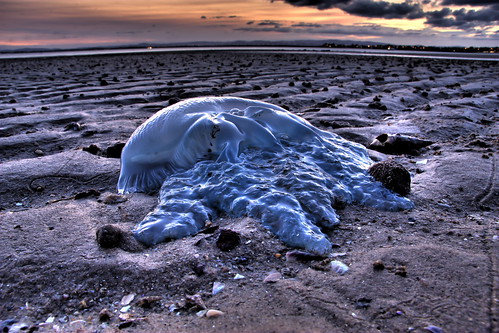
Stranded Jellyfish, originalmente cargada por Garry'.
Since jellyfish are not fish, some people consider the term "jellyfish" a misnomer, and instead use the term "jellies" or "sea jellies". The word "jellyfish" is also often used to denote either hydrozoans or the box jellyfish, the cubozoans. The class name, Scyphozoa, comes from the Greek word skyphos, denoting a kind of drinking cup and alluding to the cup shape of the organism. A group of jellyfish is often called a "smack".
When stung by a jellyfish, first aid may be needed immediately. The stings of true Scyphozoan jellyfish are not generally deadly, though species of the completely separate phylum Cubozoa (box jellyfish) such as the famous and especially toxic Irukandji can be fatal. However, even nonfatal jellyfish stings are known to be extremely painful. Serious stings may cause anaphylaxis and may result in death. Hence, people stung by jellyfish must get out of the water to avoid drowning. In serious cases, advanced professional care must be sought. This care may include administration of an antivenin and other supportive care such as required to treat the symptoms of anaphylactic shock.
There are three goals of first aid for uncomplicated jellyfish stings: prevent injury to rescuers, inactivate the nematocysts, and remove any tentacles stuck on the patient. To prevent injury to rescuers, barrier clothing should be worn. This protection may include anything from panty hose to wet suits to full-body sting-proof suits. Inactivating the nematocysts, or stinging cells, prevents further injection of venom into the patient.




